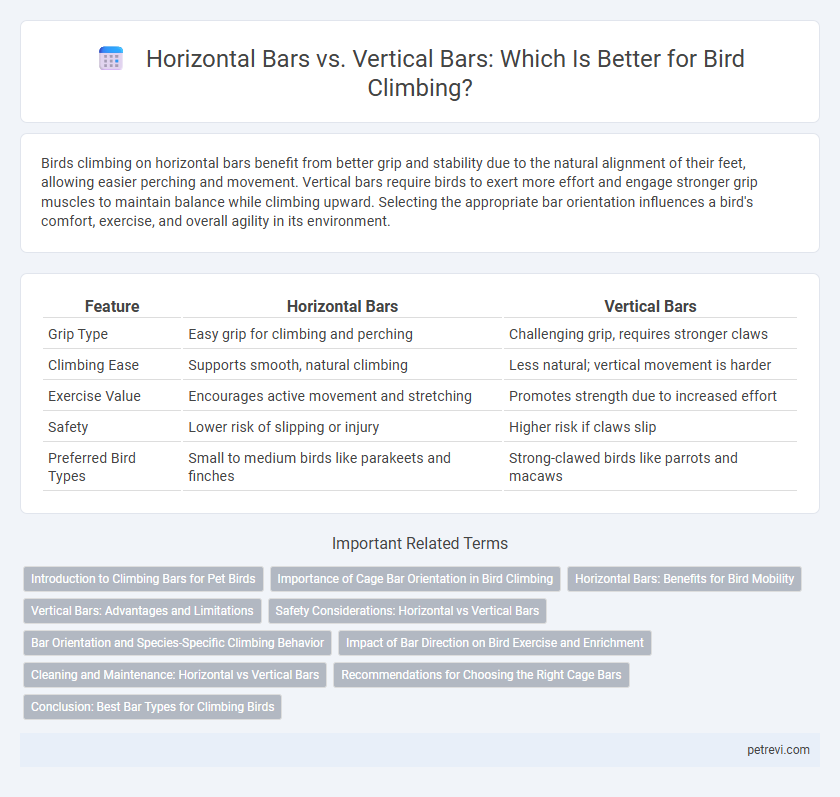Birds climbing on horizontal bars benefit from better grip and stability due to the natural alignment of their feet, allowing easier perching and movement. Vertical bars require birds to exert more effort and engage stronger grip muscles to maintain balance while climbing upward. Selecting the appropriate bar orientation influences a bird's comfort, exercise, and overall agility in its environment.
Table of Comparison
| Feature | Horizontal Bars | Vertical Bars |
|---|---|---|
| Grip Type | Easy grip for climbing and perching | Challenging grip, requires stronger claws |
| Climbing Ease | Supports smooth, natural climbing | Less natural; vertical movement is harder |
| Exercise Value | Encourages active movement and stretching | Promotes strength due to increased effort |
| Safety | Lower risk of slipping or injury | Higher risk if claws slip |
| Preferred Bird Types | Small to medium birds like parakeets and finches | Strong-clawed birds like parrots and macaws |
Introduction to Climbing Bars for Pet Birds
Horizontal bars provide pet birds with natural grip and ease of movement, closely mimicking branches found in their natural habitats. Vertical bars challenge birds by requiring more strength and balance, promoting muscle development and mental stimulation. Selecting the appropriate bar orientation enhances climbing skills and overall physical health for pet birds.
Importance of Cage Bar Orientation in Bird Climbing
Cage bar orientation significantly influences a bird's climbing abilities, with horizontal bars providing essential grip and footholds that facilitate natural climbing behavior. Vertical bars, while structurally sound, limit the bird's ability to climb effectively and can restrict exercise opportunities crucial for physical and mental health. Optimal cage design incorporates horizontal bars to promote agility, enhance muscle development, and prevent behavioral issues in climbing bird species.
Horizontal Bars: Benefits for Bird Mobility
Horizontal bars enhance bird mobility by providing multiple grip points that mimic natural tree branches, promoting better balance and coordination. These bars encourage dynamic movements and wing exercise, essential for muscle development and overall agility. Their design supports natural perching behavior, reducing stress and improving the bird's physical health.
Vertical Bars: Advantages and Limitations
Vertical bars in bird cages provide natural perching positions that mimic tree branches, promoting healthier foot grip and enhanced climbing activity. They facilitate vertical movement and exercise, supporting bird agility and preventing obesity, though spacing must be appropriate to avoid injury or escape risks. Limitations include reduced horizontal foot engagement and potential stress for species that prefer flat surfaces, requiring balanced habitat design.
Safety Considerations: Horizontal vs Vertical Bars
Horizontal bars offer better grip and stability for birds during climbing, reducing slip risks and enhancing overall safety. Vertical bars can pose a challenge as birds may struggle to maintain foothold, increasing chances of falls or injuries. Choosing horizontal bars promotes safer and more natural climbing behavior, particularly for species prone to frequent vertical movement.
Bar Orientation and Species-Specific Climbing Behavior
Birds exhibit species-specific climbing behaviors that are influenced by the orientation of bars in their environment, with vertical bars favoring species like woodpeckers and nuthatches that grip tree trunks and climb upward using strong feet and stiff tails. Horizontal bars are more suited to species such as parrots and crows, which use them to perch, balance, and move laterally, leveraging their zygodactyl feet for better grip. Understanding the climbing mechanics linked to bar orientation helps optimize habitat design and enrichment for different bird species in captivity or rehabilitation.
Impact of Bar Direction on Bird Exercise and Enrichment
Horizontal bars stimulate natural perching and gripping behaviors in birds, promoting muscle development and joint flexibility through varied movement patterns. Vertical bars enhance climbing challenges, encouraging birds to engage different muscle groups and improve coordination, which contributes to physical enrichment. The combination of both bar directions offers a balanced exercise environment that supports overall avian health and mental stimulation.
Cleaning and Maintenance: Horizontal vs Vertical Bars
Horizontal bars on bird cages collect more droppings and debris, making cleaning more frequent but easier to access with standard cage cleaning tools. Vertical bars tend to accumulate less waste directly on them, reducing the need for constant wiping, but can trap dirt in the corners, requiring occasional deep cleaning. Choosing between horizontal and vertical bars impacts maintenance time and cleaning efficiency, especially in cages for messy bird species like parrots or cockatoos.
Recommendations for Choosing the Right Cage Bars
Choosing the right cage bars for bird climbing involves prioritizing horizontal bars, which provide better grip and facilitate natural climbing behavior for species like parrots and cockatiels. Vertical bars limit climbing opportunities and can cause discomfort, whereas horizontal bars encourage exercise and mental stimulation. Opt for cage designs with sturdy, evenly spaced horizontal bars to ensure safety and promote healthy activity.
Conclusion: Best Bar Types for Climbing Birds
Vertical bars provide optimal grip and natural climbing motion for birds, enhancing their exercise and mental stimulation. Horizontal bars support perching and walking but limit climbing efficiency and natural behavior. Combining vertical bars with horizontal perches creates the best environment for active, climbing bird species.
Horizontal bars vs Vertical bars for Bird climbing Infographic

 petrevi.com
petrevi.com